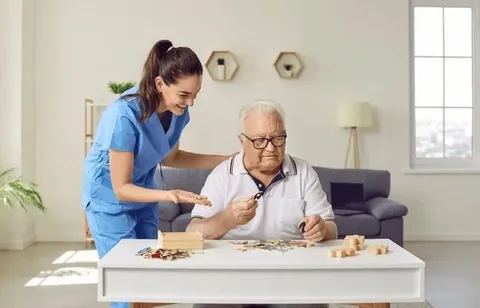As longer lifespans intersect with rising dementia rates, families are actively researching specialized memory care options that protect dignity while delivering evidence-based support. Purpose-built memory communities, advanced day programs, and hybrid “aging-in-place” models now give older adults—and the relatives who advocate for them—far more nuanced choices than were available a decade ago.
Understanding Modern Memory Care Needs
Dementia and Alzheimer’s disease affect an estimated 57 million people worldwide, a figure projected to nearly triple by 2050.¹ Symptoms progress at different speeds, but most residents eventually require:
- 24/7 supervision in a secure yet calming environment
- Consistent, dementia-trained staff to reduce anxiety
- Structured routines that cue orientation (time, place, person)
- Tailored activities to slow cognitive decline and preserve purpose
Well-designed memory care communities weave all four elements into daily life.
Key Features of Specialized Memory Care Communities
1. Purpose-Built Architecture & Design
- Circular corridors prevent dead ends that trigger confusion.
- Clearly marked “neighborhoods” help residents identify their suites.
- Controlled natural lighting minimizes sundowning agitation.
- Hidden exits and unobtrusive security keep wandering residents safe without evoking an institutional feel.
2. Dementia-Specific Programming
Evidence suggests that multi-sensory stimulation—aromatherapy, music therapy, reminiscence rooms—eases anxiety and improves mood.² Robust schedules might include:
| Time | Sample Activity | Therapeutic Goal |
| 9 a.m. | Seated Tai-Chi | Balance & vestibular health |
| 11 a.m. | Baking group | Procedural memory activation |
| 2 p.m. | Personalized playlists | Reduce agitation & evoke memories |
| 4 p.m. | Garden walks | Vitamin D, circadian alignment |
3. Highly Trained, Consistent Staff
Turnover is the silent enemy of dementia care. Leading operators exceed state minimums by:
- Requiring 8–20 hours of annual continuing education on progressive dementia theories.
- Embedding positive-approach care (PAC) techniques to maintain resident autonomy.
- Scheduling staff on dedicated “pods” so residents see familiar faces every shift.
Evidence-Based Therapies Gaining Traction
| Therapy | How It Works | Research Snapshot |
| Cognitive Stimulation Therapy (CST) | Small-group themed sessions twice weekly | Shows significant gains in language & memory over 7 weeks³ |
| Montessori-Inspired Tasks | Break complex tasks into sequenced steps, use real-life objects | Improves engagement & self-esteem in mid-stage dementia⁴ |
| Low-Frequency Light Therapy | Pulsed 40 Hz light believed to reduce amyloid beta buildup | Early trials show brain-wave synchronization & better recall⁵ |
In top communities, these therapies are folded seamlessly into residents’ care plans rather than offered à la carte.
Family Support & Transparency
Specialized programs succeed when relatives remain partners, not spectators. Hospitable operators provide:
- Secure family portals with real-time care notes and photos.
- Monthly support groups led by dementia-certified social workers.
- Care conferences every 90 days to adjust goals.
This transparency builds trust and eases caregiver guilt.
Choosing the Right Program: A 6-Step Checklist
- Clarify clinical needs—behavioral challenges vs. primarily memory loss.
- Tour at varied times (morning and evening) to gauge staffing patterns.
- Ask turnover rates for frontline aides and nurses.
- Review state inspection reports for medication-error trends.
- Sample a meal and an activity to test resident engagement.
- Verify financial models (all-inclusive vs. tiered care) to anticipate cost escalations.
When comparing communities, families should insist on seeing program calendars, not marketing brochures alone.
The Rise of Hybrid and At-Home Solutions
Not every older adult requires immediate relocation. Emerging options include:
- Memory day centers attached to skilled facilities—families can keep loved ones at home overnight while accessing therapies during business hours.
- Small-house dementia cottages (10–12 residents) that replicate single-family living with universal caregivers.
- Tech-enabled aging-in-place packages—ambient sensors, AI fall detection, and remote medication management—bridge the gap until residential care is unavoidable.
Why Specialized Care Outperforms General Assisted Living
While traditional assisted-living residences offer valuable socialization, they often lack dementia-specific staff ratios, environmental cues, and therapeutic depth. Purpose-built memory care programs demonstrably:
- Lower psychotropic medication use
- Decrease fall incidents
- Prolong functional independence
Families can explore comprehensive specialized memory care options to ensure their loved ones benefit from these advantages.
Conclusion
With innovative therapies, thoughtfully engineered spaces, and intensively trained staff, today’s specialized memory care options empower aging adults to retain identity, purpose, and joy—even in the face of cognitive decline. Families who invest time in evaluating programs through on-site visits and data-driven questions can match their loved one with a community that not only safeguards health but celebrates a life story still unfolding.


